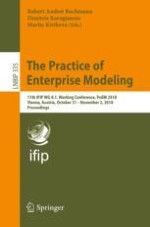2018 | Book
The Practice of Enterprise Modeling
11th IFIP WG 8.1. Working Conference, PoEM 2018, Vienna, Austria, October 31 – November 2, 2018, Proceedings
Editors: Dr. Robert Andrei Buchmann, Prof. Dr. Dimitris Karagiannis, Prof. Dr. Marite Kirikova
Publisher: Springer International Publishing
Book Series : Lecture Notes in Business Information Processing
